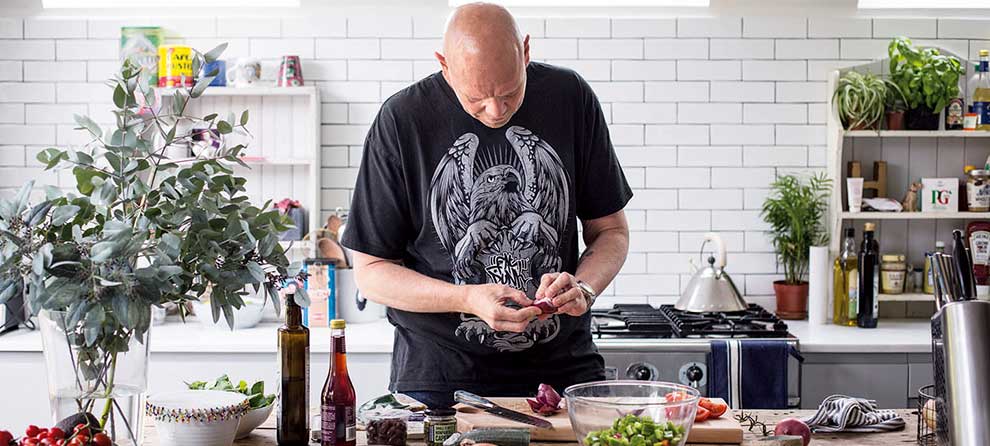Thanks to all of you who sent in your cookery questions. This month, rather than just selecting one, I decided to answer a few of your questions, check to see if yours is included. Sorry I couldn’t answer them all, but keep them coming in.
Shirley from Doncaster asked:
“Hi Tom, I’m looking for a good red onion marmalade recipe the one I tried last year was nice but took 9 hours to cook. “
My onion jam recipe from my ‘Best Ever Dishes’ cookbook, should do the trick. This sweet and savoury jam goes with so many meals and it’s really easy to make – a winner!
Makes about 450g
Ingredients:
- 1.5kg Spanish onions, halved and finely sliced
- 50g demerara sugar
- 2 garlic cloves, grated
- 120ml water
- 100ml cider vinegar
- ½ tbsp thyme leaves
Method:
- Place the onions in a large, heavy-bottomed, non-stick pan. Add the sugar, garlic, water and cider vinegar. Cook over a medium heat, stirring to dissolve the sugar.
- Continue to stir at frequent intervals until the jam is thick, brown and sticky – this will take up to an hour.
- Remove from the heat and cool. When cold, stir in the thyme. Seal in a sterilised jar or container. It will keep for up to a week in the fridge.
Hilary from Wrexham asked:
“Hi Tom I see ‘umami’ everywhere! What is it, where did it come from and how do I work it into my cookery?”
Umami is essentially a savoury ‘meaty’ flavour that we crave, often called the 5th sense of taste. The others being sweet, bitter, salty, and sour.
It’s naturally found in proteins like pork, beef, fish, shellfish and vegetables like tomatoes, mushrooms, and seaweeds are also high in umami. Whether intentionally or unintentionally, we often add umami whenever it seems like something is missing in our food. Umami boosters that are great to stock your cupboard include ketchup, miso, truffle oil and soy sauce, to name a few.
Alison from Romford asked:
“Hi. Have just been salivating over your recipe for Shepherds Pie. Easy question; the oven temperatures – which type of oven are they for? ie. fan?”
You’re right this is an easy one. Cook my Shepherds Pie for 45 minutes at 200c fan oven/ 220c/ or gas mark 5.
Sophie for Coventry asked:
“When making vegetable purées whether it be pea, onion, cauliflower etc how do you stop it from being grainy? Many thanks Pirate.”
For vegetable purees, I’d recommend making sure they are cooked out long enough so that they don’t have any hard fibres left. Then use a proper blender with a sharp blade to blitz the vegetable until smooth. Pass through a fine sieve to ensure any little bits are left in the sieve rather than the puree.
Ash from Buckinghamshire asked:
“Tom – what’s your advice for filleting flat fish? What’s the best knife to use and what’s the best approach to minimise any waist? Thanks. ”
Check out my YouTube video on ‘How to fillet a fish’.
Katrina from Aylesbury asked:
“My fiancé’s aunt owns a fresh fish shop on the Eastbourne seafront and every Christmas we get fresh fish of our choice to take back home to Aylesbury. Recently I went to an Indian restaurant and had monkfish that was infused in tikka like spices as part of a sea platter. How can I recreate this bearing in mind the fish we take home we usually have to freeze… So would need to take defrosting into account.”
Although I can’t tell you how to recreate the dish, here’s my advice on freezing monkfish. Before you freeze, I suggest brining, this will keep it moist when defrosted.
To make the brine use 500ml of cold water and 50g table salt whisked together. Add the monkfish and leave in the brine for 20 minutes. Drain, pat dry, then wrap and freeze.
Monkfish is the best fish for curries as it’s meaty and robust. Just defrost slowly in the fridge and then use as you would for a chicken curry. Why not try my monkfish curry, easy to make and is the perfect winter comfort food. Click here to view.
Wayne from Chelsea Heights, Australia asked:
“I am trying to cook pork loin about 4 inches diameter with skin. Clearly I want some nice crackling but I don’t want the pork to be dry. Any hints will be greatly appreciated.”
I suggest brining the pork loin first. The brine will help keep the pork moist and will also season the meat.
To make the brine use 500ml of cold water and 50g table salt whisked together. Add the pork and leave in the brine for 2 hours. Remove and dry out in the fridge, don’t wrap in cling film or foil, just leave uncovered so that the skin dries out.
Start by cooking the pork in a hot pan, skin side down and slowly cook out till it starts to pop and crisp up. Once the skin is crisp cook the loin in the oven as you normally would.




